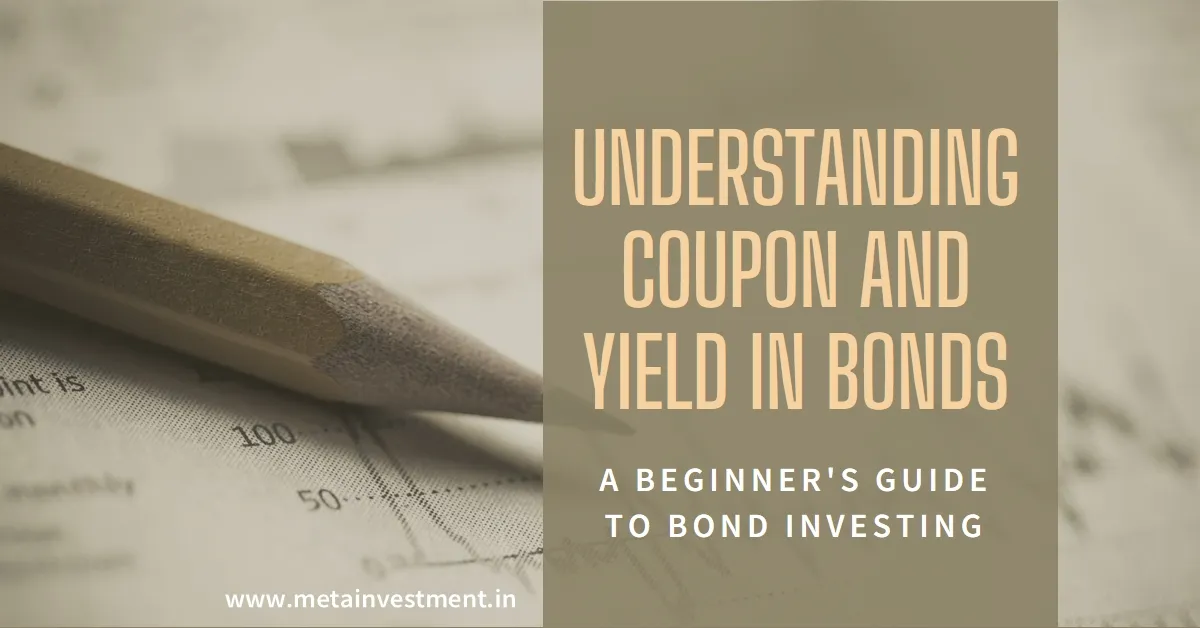If you’re venturing into the world of bonds, you’ll often come across the terms yield and coupon. While they both relate to the interest you earn from a bond, understanding their differences is crucial for making informed investment decisions. Let’s break it down in simple terms.

Coupon: Your Guaranteed Interest Payment
Think of a bond’s coupon like the interest rate on your savings account. It’s a fixed percentage of the bond’s face value (also called par value) that the issuer promises to pay you regularly, usually semi-annually or annually. This rate is set when the bond is issued and remains the same throughout the bond’s life.
Example:
You buy a bond with a face value of ₹1,000 and a 5% coupon rate. This means you’ll receive ₹50 (5% of ₹1,000) in interest payments each year until the bond matures.
Yield: Your Actual Return on Investment
While the coupon rate is fixed, a bond’s yield can fluctuate. It represents the actual return you can expect from the bond if you hold it until maturity. This is where things get interesting because the yield isn’t always equal to the coupon rate.
How Does Yield Change?
The yield changes based on the bond’s current market price. Here’s how it works:
-
Bond Price and Yield Move in Opposite Directions: When a bond’s price goes up, its yield goes down, and vice versa.
-
Discount Bonds: If you buy a bond for less than its face value (at a discount), your yield will be higher than the coupon rate.
-
Premium Bonds: If you buy a bond for more than its face value (at a premium), your yield will be lower than the coupon rate.
Example:
Let’s say the ₹1,000 bond with a 5% coupon rate is now selling for ₹900 in the market. Your annual interest payment is still ₹50, but since you paid less for the bond, your yield is higher. You can calculate the current yield by dividing the annual interest payment ( ₹50) by the current market price ( ₹900), which equals approximately 5.56%.
Why Do Yields Change?
Several factors can influence a bond’s price and yield:
-
Interest Rates: When prevailing interest rates rise, existing bonds with lower coupon rates become less attractive, causing their prices to fall and yields to rise.
-
Credit Rating: The issuer’s creditworthiness affects the bond’s perceived risk. Lower-rated bonds usually offer higher yields to compensate investors for the increased risk.
-
Time to Maturity: Bonds with longer maturities generally have higher yields because there’s more uncertainty about the future.
Yield To Maturity
While the current yield is helpful, it doesn’t give you the complete picture. It’s essential to consider the yield to maturity (YTM), which takes into account the bond’s current market price, coupon payments, and time to maturity. YTM gives you a more accurate estimate of your total return if you hold the bond until it matures.
In bond terms:
- YTM is the total return you can expect from a bond if you hold it until it matures.
- It factors in:
- The bond’s current market price.
- All the coupon payments you’ll receive.
- The final face value payment at maturity.
- YTM is expressed as an annual percentage rate, making it easier to compare different bonds.
Example:
Let’s say you buy a ₹1,000 bond with a 5% coupon rate that matures in 5 years. This means you’ll get ₹50 in interest each year for 5 years, and then your ₹1,000 back at the end.
-
Scenario 1: Buying at Par
- You buy the bond for ₹1,000 (its face value).
- Your YTM would simply be the coupon rate, 5%.
-
Scenario 2: Buying at a Discount
- You find the bond on sale for ₹900.
- Your YTM would be higher than 5% because you’re getting the same interest payments (₹50 per year) but also a ₹100 profit at maturity.
-
Scenario 3: Buying at a Premium
- The bond is in high demand, and you have to pay ₹1,100 for it.
- Your YTM would be less than 5% because you’re paying extra upfront, and the ₹100 loss at maturity offsets some of your interest earnings.
Why YTM Matters:
-
Comparison: YTM lets you compare the potential return of different bonds, even if they have different coupon rates, prices, or maturity dates.
-
Investment Decisions: YTM helps you assess whether a bond is a good fit for your investment goals and risk tolerance. A higher YTM usually means higher potential return, but also potentially higher risk.
-
Pricing: YTM plays a role in determining a bond’s market price. As interest rates change, the YTM of existing bonds adjusts, leading to price fluctuations.
Important Considerations:
-
Reinvestment: YTM assumes you’ll reinvest your coupon payments at the same rate as the YTM. If interest rates change, this may not be possible.
-
Call Risk: Some bonds can be redeemed early by the issuer (called), which could affect your YTM.
While calculating YTM manually can be complex, many financial calculators and websites have tools that make it easy. By understanding YTM, you’ll be better equipped to navigate the bond market and make informed investment decisions.
Wrapping Up
Understanding the difference between yield and coupon is essential for navigating the bond market. The coupon rate is the fixed interest payment you’ll receive, while the yield reflects your actual return on investment based on the bond’s current market price. By understanding how these two factors interact, you can make informed decisions and choose bonds that align with your financial goals.













